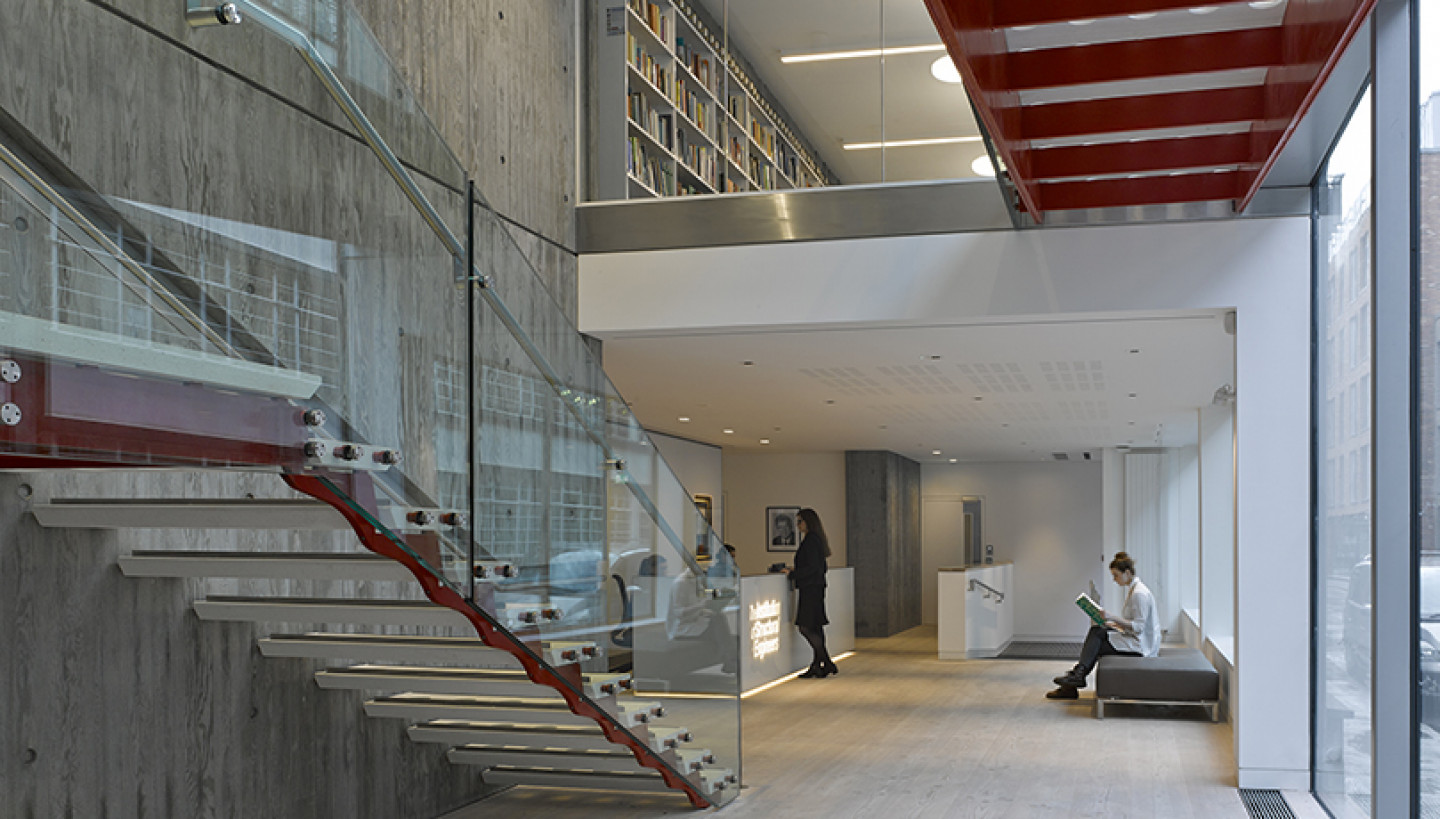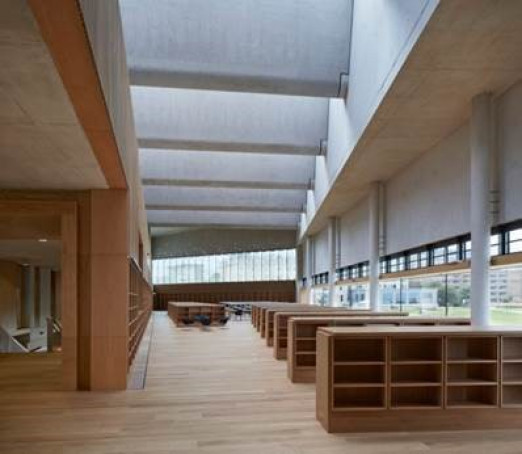Hugh Broughton Architects is the architect of The Institution of Structural Engineers’ new headquarters in Islington.
It has enabled the institution, the world’s largest membership organisation dedicated to the art and science of structural engineering, to move from its former location on Upper Belgrave Street SW1, where it has been based since 1926.The project is the retrofit of an inconspicuous 4-storey 1960s office building which has been transformed into a modern, thriving workplace. It celebrates a spirit of collaboration between architect, engineer and client, showcases the application of sustainability in retrofit and reflects the philosophy and values that have always underpinned the Institution.
The new headquarters are located on Bastwick Street in the London Borough of Islington, in Clerkenwell, a central London district with a high concentration of architects and engineers. The new glass-fronted building will enhance the institution’s role within the professional community, providing a public conference centre, members’ facilities and library, as well as flexible workspaces for the Institution’s 55 permanent staff.
The 1600 sq m development has a wide but shallow plan, and the design takes advantage of this by utilising the expansive elevation for public-facing facilities with ancillary facilities such as toilets, cloak room, servery and plant on the darker south side placed behind a series of walls which step in plan from the entrance.
The north elevation, which was characterised by a rigorous pattern of windows, has been opened up with a dramatic double-height glass-fronted foyer at street level, which floods the entrance with light.
The entrance reception and foyer exhibition space showcases the four principal building materials for creating structure: timber, glass, steel and concrete.
A finely detailed, horizontal-cantilevered staircase in pre-cast concrete and steel, designed with Expedition Engineering, is a contemporary reinterpretation of the traditional cantilevered stone stair that characterised the institution’s former building on Upper Belgrave Street. The stair is supported on one side by an exposed in situ concrete wall, with the textural grain of the Douglas fir shuttering imprinted into its surface. The treads are supported by a gracefully shaped minimalist red steel stringer and formed in white pre-cast concrete punched with cast glass lenses which diffuse light through the stair. The treatment continues in the atrium bridge opposite, where the shape of the bridge reflects the structural bending moment. Set behind the new glazed double-height façade and illuminated at night, the stair is clearly visible from the street, and will become a motif for the pioneering design that the institution supports.
The ground level is accessible to all and includes a 104-seat auditorium and meeting rooms, with state of the art audio visual, video conference and web casting facilities. As you move up the building the spaces become increasingly private, with the members' facilities including a library and business centre flanking the double-height atrium on the first floor. The upper levels are reserved for staff offices, which include open plan workspaces, cellular offices and meeting rooms fitted with video conference facilities.
The project was designed with sustainability as a design focus, reflecting the ambitions of its members. The retrofit incorporates passive sustainable measures including thermal improvements to the walls and roof, achieved with high levels of insulation and reduced air permeability. Minimising the requirement for new structure limited resource use and the associated embodied energy. New materials have been responsibly sourced from suppliers with environmental accreditation. The Dinesen timber floors are from sustainable European forests. In the construction of the concrete wall, the Douglas fir timber shuttering has been reused to make the timber entrance doors and to clad a new extension within the rear courtyard, which houses audio-visual equipment and furniture storage.
Extensive thermal modelling was carried out to assess the viability of natural ventilation and passive cooling options. The single aspect and depth of floor plate resulted in areas of the office which would have been poorly ventilated, so this proved not to be feasible.
Environmental building services strategies include:
• A new heat recovery ventilation system to provide controlled ventilation flow rates to prevent overheating and allow minimum energy consumption when cooling is not required
• High efficiency and fully controlled ventilation and cooling plant including air source heat pumps takes advantage of free cooling under appropriate enthalpy conditions
• Use of high efficiency LED lighting and zoned PIR lighting controls in office areas with daylight dimming reduces energy consumption of lighting and switches off lighting when not required
• Installation of BMS system to monitor and maintain mechanical services, reducing energy consumed and allowing systems to be accurately controlled and to be switched off when not required
• New efficient boilers for hot water and ancillary heating minimise gas consumption
Aside from the building services the new headquarters also promote a culture of reducing their members’ carbon footprint. By vastly improving connectivity, the new video conferencing and webinar facilities offer a leap forward in the way members engage, and significantly reduce the requirement for international travel.
Hugh Broughton, Director Hugh Broughton Architects said:
‘The design of the new home for The Institution of Structural Engineers demonstrates the impact of collaboration between an enlightened client with architects and engineers in creating designs of transparency, clarity and elegance. To deliver the designs and produce the exceptional quality of the finished project bears testament to the energy of everyone involved.’
Martin Powell, Chief Executive, The Institution of Structural Engineers said:
‘Bastwick Street offers a leap forward for the Institution and our members. Our improved video conferencing and webinar abilities will vastly improve connectivity among the international membership, while our new business centre and adaptable events spaces make for a much enhanced visitor experience.
As well as a home for our members, Bastwick Street provides a great advertisement for the structural engineering profession. We have created a modern workplace, delivering pragmatic and responsible sustainability solutions throughout the construction process – while also celebrating structural design. The result is a new home which delivers better operations, while never forgetting the philosophy and values that have always underpinned our work'
Julia Ratcliffe, Director for the project from Expedition Engineering and Fellow of the Institution of Structural Engineers said:
‘Expedition were honoured to be asked to work on the Institution’s new building in Bastwick Street. We recognised this was a unique opportunity to celebrate the work of our profession and those with whom we collaborate. We are very pleased with the outcome, especially in the new entrance area where it provides an element of strong structural interest. As members, we look forward to visiting the building and using the new facilities in the years ahead.’
Gross internal area: 1600 sq m
Schedule: Appointment: July 2013;
Design: August 2013 –April 2014;
Construction: Feb 2014 –Jan 2015
Client: The Institution of Structural Engineers
Architect: Hugh Broughton Architects
Design team: Hugh Broughton, Adam Knight, David Roberts
Structural & Civil Engineer: Expedition Engineering
Services Engineer: Thornton Reynolds
Main Contractor: Scott Osborn
QS & Project Management: GVA
Lighting design: Sutton Vane Associates
Acoustic Design: Ramboll
Concrete Consultant: David Bennett Associates
Photographer: James Brittain


